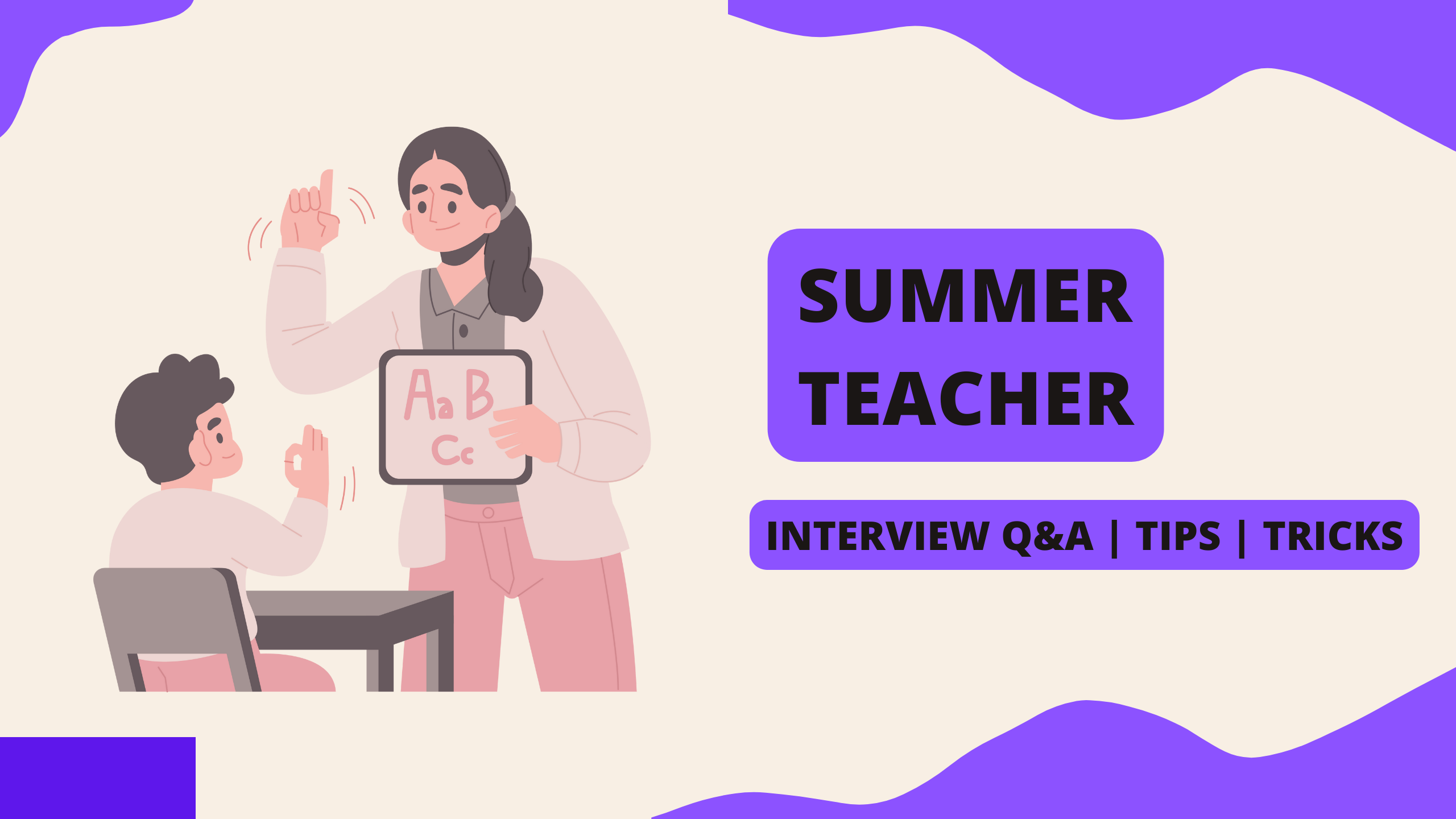Blog Detail

15 Common Interview Q&A for High School Teacher in South Africa
May 16, 2024
15 Common
Interview Q&A for High School Teacher in South Africa Are you passionate about
education and eager to inspire the next generation of learners in South Africa?
Landing a high school teaching position in the country requires not only a strong
educational background but also exceptional interview skills. Whether you're a
seasoned educator or a fresh graduate, this guide will walk you through the key
steps to ace your high school teacher interview in South Africa. 1. Research the School and Curriculum Before you even step into the
interview room, it's crucial to research the school you're applying to.
Understand its mission, values, teaching methodologies, and the demographics of
the student body. Familiarize yourself with the South African curriculum,
including the CAPS (Curriculum and Assessment Policy Statement) if applicable
to the position. 2. Prepare Your Portfolio Compile a comprehensive portfolio
showcasing your qualifications, certifications, teaching philosophy, lesson
plans, and any relevant experience on professional
high school teach cv in south Africa. Highlight your accomplishments, such
as student outcomes, innovative teaching methods, and extracurricular
involvement. Ensure your portfolio reflects your commitment to student success
and engagement. 3. Understand the Education Landscape in South Africa Demonstrate your understanding of
the challenges and opportunities within the South African education system. Be
prepared to discuss issues such as educational inequality, language barriers,
inclusive education, and cultural diversity. Show empathy and cultural
sensitivity in your responses. 4. Practice Common Interview Questions Anticipate and rehearse responses
to common interview questions tailored to the teaching profession. These may
include: Craft concise yet impactful
responses that demonstrate your passion for teaching, adaptability, and
student-centered approach. 5. Showcase Your Cultural Competence Given South Africa's rich
cultural tapestry, emphasize your cultural competence and ability to create an
inclusive learning environment. Discuss how you celebrate diversity in the
classroom, incorporate multicultural perspectives into your lessons, and foster
mutual respect among students. 6. Highlight Your Classroom Management Skills Effective classroom management is
essential for maintaining a conducive learning environment. Share specific
strategies you employ to establish rules, address behavioral issues, and
promote positive student behavior. Emphasize your ability to create a safe and
supportive classroom where every student feels valued and respected. 7. Demonstrate Your Commitment to Professional
Development Show your dedication to
continuous learning and professional growth. Discuss any ongoing professional
development activities, workshops, or courses you've attended to enhance your
teaching practice. Express your willingness to collaborate with colleagues,
participate in school initiatives, and stay updated on educational trends and
research. 8. Ask Thoughtful Questions At the end of the interview,
seize the opportunity to ask insightful questions about the school, its
culture, professional development opportunities, and the community it serves.
This demonstrates your genuine interest in the position and helps you assess
whether the school is the right fit for you. 9. Follow up with a Thank-You Note After the interview, send a
personalized thank-you note to express your appreciation for the opportunity
and reaffirm your interest in the position. Reiterate your enthusiasm for
contributing to the school's mission and goals. Preparing for a high
school teacher interview in South Africa requires thorough research,
thoughtful reflection, and effective communication. By showcasing your passion
for teaching, cultural competence, and commitment to student success, you can
position yourself as an ideal candidate for the role. Good luck! 15 Common Interview Questions for High School Teacher and
their Answers with Examples 1. Why
do you want to become a high school teacher? Sample Answer: "I have always been
passionate about education and believe that teachers play a crucial role in
shaping the future. I am inspired by the opportunity to make a positive impact
on students' lives and help them reach their full potential." 2. How
do you plan to engage and motivate high school students in your classroom? Sample
Answer: "I believe in creating a dynamic and interactive learning
environment by incorporating hands-on activities, group discussions, and
real-world examples relevant to students' interests and experiences. By
fostering a supportive and stimulating classroom culture, I aim to inspire
intrinsic motivation and a love for learning." 3. How
do you differentiate instruction to meet the needs of diverse learners? Sample
Answer: "I recognize that students have different learning styles,
abilities, and backgrounds. To accommodate diverse learners, I employ a variety
of teaching strategies, such as differentiated instruction, scaffolding, and
personalized learning pathways. I regularly assess students' progress and
adjust my teaching methods accordingly to ensure that all students are
challenged and supported." 4. Describe
a challenging classroom situation you have encountered and how you handled it.
Sample
Answer: "During a group project, I noticed that some students were not
collaborating effectively, and conflicts arose. I facilitated a class
discussion to address the issues openly and encouraged students to voice their
concerns. Through active listening, mediation, and problem-solving strategies,
we were able to resolve the conflicts and foster a more collaborative learning
environment." 5. How
do you incorporate technology into your teaching? Sample
Answer: "I leverage technology as a tool to enhance teaching and
learning experiences. For example, I integrate multimedia presentations,
interactive whiteboards, educational apps, and online resources to engage
students and facilitate active participation. By embracing technology, I aim to
foster digital literacy skills and prepare students for success in the
21st-century workforce." 6. What
strategies do you use to assess student learning? Sample
Answer: "I employ a variety of formative and summative assessment
methods, including quizzes, tests, projects, presentations, and peer
evaluations. Additionally, I use rubrics and checklists to provide clear
criteria for success and offer constructive feedback to help students improve.
By using a balanced assessment approach, I ensure that I have a comprehensive
understanding of students' progress and mastery of the content." 7. How
do you handle classroom management and discipline? Sample
Answer: "I believe in proactive classroom management strategies that
emphasize clear expectations, positive reinforcement, and mutual respect. I
establish classroom rules collaboratively with students and enforce them
consistently. In the event of behavioral issues, I address them promptly and
constructively, focusing on solutions rather than punishment. By building
strong relationships with students based on trust and empathy, I create a
supportive learning environment conducive to academic success." 8. Describe
your experience working with students from diverse cultural backgrounds. Sample
Answer: "Throughout my teaching career, I have had the privilege of
working with students from diverse cultural backgrounds. I celebrate cultural
diversity in the classroom by incorporating multicultural perspectives into my
lessons, promoting cross-cultural understanding, and creating opportunities for
students to share their cultural experiences. By fostering an inclusive
learning environment that values diversity, I empower students to appreciate
and respect each other's differences." 9. How
do you collaborate with colleagues, parents, and community members? Sample
Answer: "I believe that collaboration is essential for student
success. I actively collaborate with colleagues to share best practices,
develop interdisciplinary projects, and support each other in addressing the
needs of our students. I maintain open communication with parents through
regular updates, parent-teacher conferences, and involvement in school events.
Additionally, I engage with community members by participating in outreach
programs, volunteer opportunities, and partnerships that enrich the educational
experience for our students." 10. How
do you stay updated on educational trends and research? Sample
Answer: "As a lifelong learner, I prioritize professional development
and stay updated on educational trends and research through workshops,
conferences, webinars, and academic journals. I am a member of professional
organizations such as [insert organization], where I collaborate with peers,
attend seminars, and access resources to enhance my teaching practice. By
staying informed about current educational theories and practices, I
continually refine my teaching strategies to meet the evolving needs of my
students." 11. Can
you describe a successful lesson plan you implemented? Sample
Answer: "One successful lesson plan I implemented was a project-based
learning activity where students researched and presented on a historical event
from multiple perspectives. I scaffolded the lesson by providing guiding
questions, resources, and checkpoints throughout the process. Students
collaborated in groups, conducted research, analysed primary sources, and
created multimedia presentations to showcase their findings. The project
culminated in a gallery walk where students shared their work and engaged in meaningful
discussions. This lesson not only fostered critical thinking and research
skills but also promoted empathy and understanding of different
viewpoints." 12. How
do you address the needs of students with learning disabilities or special
needs? Sample
Answer: "I believe in inclusive education and strive to create a
supportive learning environment where all students can thrive. To address the
needs of students with learning disabilities or special needs, I collaborate
with support staff, such as special education teachers and counsellors, to
develop Individualized Education Plans (IEPs) and accommodations tailored to
each student's strengths and challenges. I provide differentiated instruction,
assistive technologies, and additional support as needed to ensure that every
student has equal access to the curriculum and opportunities for success." 13. What
is your approach to fostering critical thinking skills in your students? Sample
Answer: "I believe that critical thinking is essential for academic
success and lifelong learning. I incorporate inquiry-based learning,
problem-solving activities, and Socratic questioning techniques to stimulate
students' critical thinking skills. I encourage students to analyze information
critically, evaluate evidence, consider multiple perspectives, and construct
well-reasoned arguments. By engaging students in challenging tasks and
fostering a culture of curiosity and intellectual exploration, I empower them
to think critically and become independent learners." 14. How
do you address the needs of gifted or high-achieving students in your
classroom? Sample
Answer: "I recognize the importance of providing enrichment
opportunities for gifted or high-achieving students to maximize their
potential. I differentiate instruction by offering advanced content, extension
activities, and independent projects that cater to their interests and
abilities. I also encourage these students to take on leadership roles, mentor
their peers, and pursue independent research projects. By nurturing their
talents and fostering a growth mindset, I support their intellectual development
and academic growth." 15. Can
you describe a time when you collaborated with colleagues to improve teaching
practices? Sample
Answer: "In my previous school, I collaborated with a team of teachers
to implement a new instructional strategy aimed at improving student engagement
and academic performance in mathematics. We conducted action research, attended
professional development workshops, and observed each other's classes to
exchange feedback and ideas. Through collaborative planning, reflection, and
data analysis, we refined our teaching practices and developed innovative
approaches to meet the diverse needs of our students. As a result, we saw
significant improvements in student learning outcomes and a positive shift in
classroom culture."








